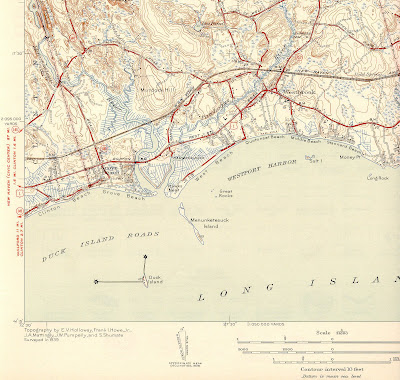1.jpg)

I can’t find what I started writing about last, but it was after July 5, 2008, the day I discovered the bull’s eye ring associated with Lyme Disease. It was a rough 3 weeks and then some, feeling the effects of the disease and suffering from the side effects of the anti-biotic.
But I ended up camping in my mom’s back yard down in Westbrook CT at the end of those three weeks, slowly feeling better. It's the house circled in red on this 1940's map - and found an interesting Rock Pile on a Stone Row that is the big red dot:

“Westbrook was settled in 1648 as Pochoug, an Indian word meaning "at the confluence of two rivers", the Pochoug and the Menunketesuck, by the residents of the Saybrook Colony. Pochoug was the dwelling place of Obed and his tribe until 1676. The community was incorporated as Third or West Parish in 1724 by an Act of the General Assembly.
Westbrook is the birthplace of David Bushnell, the American patriot and inventor of the submarine (He called it the Turtle). It was visited by George Washington in 1776 and by the Marquis de Lafayette in 1824.
Pochoug was renamed Westbrook in 1810 as a town by Act of the Connecticut General Assembly of 1840.”
http://www.westbrookct.us/townhistory.php?PHPSESSID=95d44b578f52c50aa0e54ee771257020That name, Obed, pops up alot in the area:
TOWN OF WESTBROOK.By James A. PRATT
The History of Middlesex County 1635-1885J. H. Beers & Co., 36 Vesey Street, New York1884
"…(T)he Indian name of the settlement was Pochoug, a word signifying the place where a river divides, and descriptive of the location of the principal tribe at OBED's Hammock, at the confluence of Pochoug and Menunketesuc Rivers. The large quantities of arrow heads, broken pottery, shells, and other Indian remains that have been found and are being unearthed in that vicinity, are evidence that it was some time the abode of a numerous and powerful tribe.
A very common name for the western part of the town, in ancient annals, is Menunketeset, or Menunketesuc, in Indian dialect, Ma-na-qua-te-sett. The name is of Mohegan origin, and was applied to the West River, and the section bordering upon it, after its possession was claimed by UNCAS. In his deed to Saybrook, in 1666, it is written, Menunketeset, and it has been spelled and pronounced every conceivable way since. The significance of the word is lost. The soil on both sides of the rivers is a mass of shells, the remains of clam and oyster feasts before the discovery of America. A remarkable feature of the vicinity is the great number of broken or unfinished arrow heads to be found at Round Hill, on the east side of the river. The only explanation for this is, that it was the headquarters for the manufacture of these implements from the late and quartz found on the beach near by. This Indian settlement was probably abandoned at the annihilation of the powerful Pequot tribe, to which they belonged, in 1637.
The Hammock was subsequently occupied by OBED and his tribe, from Niantick, on the western border of Rhode Island, and within the jurisdiction of the Connecticut colony at that time. The small tribe were living here at the time of the arrival of the first whites, and were known as the Menunketeset Indians. They returned to Niantick about the time of the King Philip war, in 1676."
http://www.dunhamwilcox.net/town_hist/westbrook_hist.htmI can quote myself here:
"Histories of the Saybrook, CT area include mention of Obed and "Obed's Sacrifice Rock." Obed appears to have been a "son of a Hammonassett Chief; and after the subjugation of the Pequot, a servant to Gov. Fenwick: that Fenwick did give him...two acres more or less near the confluences of Pychaug & Menunketezuck rivers, known as Obed's Homake."
He later lived near Springbrook Rd, "passing most of his time in the retirement of his wigwam or the solitude of the chase." Obed's Sacrifice Rock was a boulder "contiguous" to his "aboriginal structure." The author continues to write in a language somewhat similar to American English, "Upon this symbol of pristine faith, was kindled from time to time, a fire which consumed the sacrifices tendered, with sweet incense from bay and birch; mingled with the fumes of tobacco." "
http://www.neara.org/macsween/macsween.htmA little more OBED from
The History of Middlesex County 1635-1885
J. H. Beers & Co., 36 Vesey Street, New York
1884
Pages 282-320
TOWN OF OLD SAYBROOK.
BY WILLIAM B. TULLY
After the Indians were subdued, some of them were servants to the whites, and others lived near them and became partially civilized, many of them taking English names. They gradually decreased, however, till at the beginning of the present century, only a few stragglers remained. The tradition has come down to us, that Obed, one of these Indians, sacrificed a deer to the Great Spirit on a hill about half a mile north of the head of Main street. The hill is still known as "Obed's Alter Hill," though the exact rock on which the sacrifice took place is not known. It was, however, one of the high rocks on the east side of the hill, and it is not visible from the turnpike. Who this Obed was is not known, but an Indian of that name was a servant of Colonel FENWICK, and it is probable that he was the one. Years afterward he laid claim to a piece of land, which the following entry in the town acts explains: "The Teste of William HIDE and Morgan BOWERS, who certife & say that wee do well Remember that Obed the Indian was a servunt of Mr. FENWICK the space of four years, & we are able to say he was a faithful servant to him, & that for his service, Mr. FENWICK Did Ingage a parcel of Land to him, We cannot Justly Say what Quantity, But we Do conclude it was not less than four acres, and that Obed's father Did Possess the Land before the Serviss of the said Obed was out. To this we Can Safely take our oaths.
"This was given in before me, John MASON, the 19th of May 1673."
My mom's yard today - and the rock pile again in red:

There's been lots of newer stone walls built since the 1600's, but I think I see the "Indian Look" of the oldest of stone rows (built very similar to rows I've follwed in Rhode Island) and I wish I'd had the time to just follow those stone rows rather than just glimpse them from my bicycle as I rode by, especially in the property newly acquired by the Stewart B. McKinney National Wildlife Refuge (http://www.fws.gov/refuges/profiles/index.cfm?id=53546).
But here's the one at the edge of the property.



In the distance is I-95; that sort of hump in the middle of this section of stone row is a sort section of stone row that ends with a big end stone above what's now a little pond, but probably was a spring:
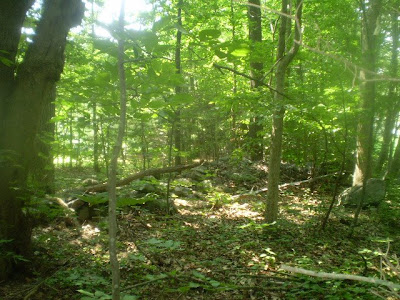
I stepped onto the highway side to take this photo of it, a steep bank below the big stone at the right, a curious collections of smaller stones on the row to the right of the the big boulder in the middle...


The few stones I did pick up, I turned in my ands until I found some comfortable way to hold it...

.. hand axe, maybe...




...but I think it's that pile of stone tools, sitting on a stone row at a spring, maybe an old camp, maybe just a spot where tools were left rather than carry around hand axes and hammer stones, abraders and nut crackers and who knows what else, right there in my mom's backyard.

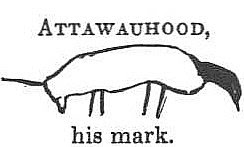







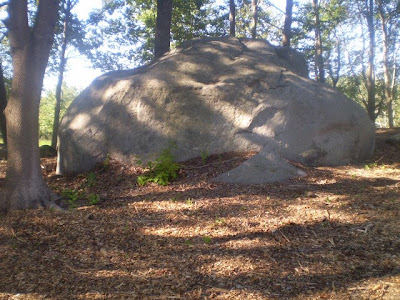

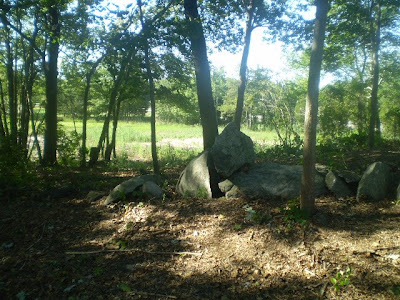


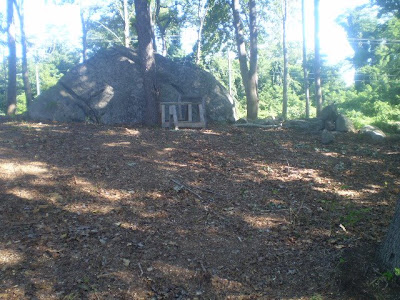


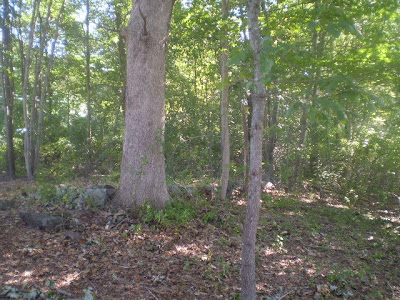

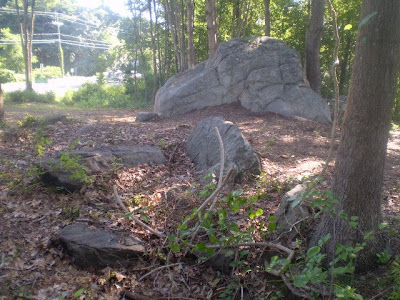








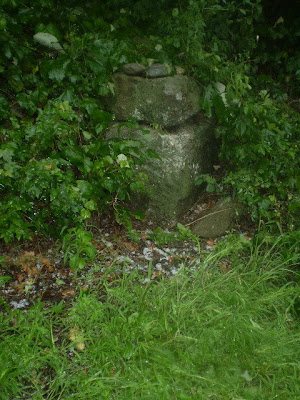






1.jpg)



1.jpg)





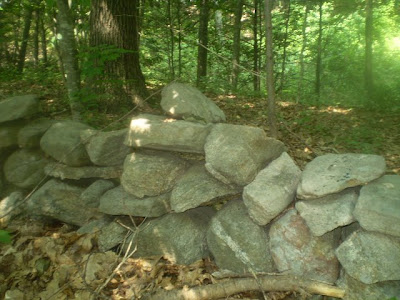




 .. hand axe, maybe...
.. hand axe, maybe...


